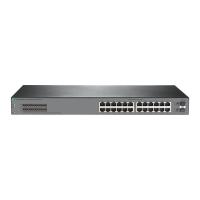158
Configuring IPv6 neighbor discovery
About IPv6 neighbor discovery
ICMPv6 messages used by IPv6 neighbor discovery
The IPv6 neighbor discovery (ND) process uses ICMP messages for address resolution, neighbor
reachability verification, and neighboring device tracking.
Table 8 de
scribes the ICMPv6 messages used by the IPv6 ND protocol.
Table 8 ICMPv6 messages used by ND
ICMPv6 message Type Function
Neighbor Solicitation (NS) 135
Acquires the link-layer address of a neighbor on the local link.
Verifies the reachability of a neighbor.
Detects duplicate addresses.
Neighbor Advertisement
(NA)
136
Responds to an NS message.
Notifies the neighboring nodes of link layer changes.
Router Solicitation (RS) 133
Requests an address prefix and other configuration information
for autoconfiguration after startup.
Router Advertisement (RA) 134
Responds to an RS message.
Advertises information, such as the Prefix Information options
and flag bits.
Redirect 137
Informs the source host of a better next hop on the path to a
particular destination when certain conditions are met.
Address resolution
This function is similar to ARP in IPv4. An IPv6 node acquires the link-layer addresses of neighboring
nodes on the same link through NS and NA messages.
Figure 57
shows how Host A acquires the link-layer address of Host B on the same link. The address
resolution procedure is as follows:
1. Host A multicasts an NS message. The source address of the NS message is the IPv6 address
of the sending interface of Host A. The destination address is the solicited-node multicast
address of Host B. The NS message body contains the link-layer address of Host A and the
target IPv6 address.
2. After receiving the NS message, Host B determines whether the target address of the packet is
its IPv6 address. If it is, Host B learns the link-layer address of Host A, and then unicasts an NA
message containing its link-layer address.
3. Host A acquires the link-layer address of Host B from the NA message.

